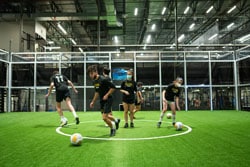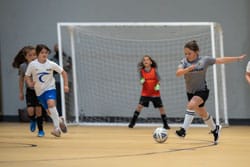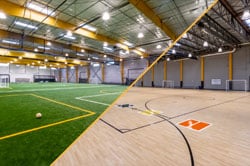Training Tips – Conditioning vs Speed
Love it or hate it, running is a core training tool used by coaches in every major sport from beginners to pros. Yet there are misconceptions regarding training conditioning versus sprinting. Here’s a breakdown of the differences and how to best utilize each for optimal results.

Love it or hate it, running is a core training tool used by coaches in every major sport. From beginners to pros, running helps increase endurance and speed while at the same time improving mental health and sleep. When implemented properly, it can improve an athlete’s performance across the board.
Yet many athletes and coaches have common misconceptions when it comes to running, specifically the focused training of conditioning versus sprinting. Many understand the basic concepts well enough –conditioning traditionally is some form of long distance running while sprinting is short fast bursts. But it’s when the two types of running are blended into one training process that your time and effort are used inefficiently.
Our expert SpeedLab coaches are here to help breakdown the differences and explain how to best utilize each for optimal results.
There are countless benefits to conditioning–from improving the lactate threshold to increase your endurance levels to strengthening your muscles and joints to prevent injury. Running for this purpose tends to be at a slow to medium intensity with incomplete rest. This means an athlete does not allow their body to fully recuperate after a period of exercise before continuing. Training when you’re tired.
An important note here is to remember to train efficiently with purpose. If an athlete goes for a long run to train to prevent fatigue at the end of the game, they are not utilizing their time efficiently. They may be improving their lactate threshold, but they are not training their decision-making skills while tired. Instead, good exercises during a conditioning practice would achieve both results.
Sprinting is full intent with full recovery. The focus here is going all out and then giving enough time in between to rest completely. Without a full recovery, the athlete cannot provide 100% effort. It stops being speed training and transitions into a less efficient form of conditioning.
So why does the body need a full rest and how long does that take? A complete rest allows the nervous system to fully recover. Sprint training attempts to create new synapses –neurons that connect the nervous system to muscle fiber. More connections means faster output. The rule of thumb for full recovery during this is about 30 seconds of rest for every 10 meters sprinted or a 1:12 work-to-rest ratio. For every second of max effort, take twelve seconds of rest.
Take a soccer player for example. Which training would serve them more on the field –conditioning or sprinting? Many would guess conditioning since they are running all over the place for hours on end. In reality, the majority is spent at a lower intensity (walk or jog) and then a sudden burst of sprint.
The key is to implement the proper training technique to elicit the desired results. Remember, always train with purpose.
Yet many athletes and coaches have common misconceptions when it comes to running, specifically the focused training of conditioning versus sprinting. Many understand the basic concepts well enough –conditioning traditionally is some form of long distance running while sprinting is short fast bursts. But it’s when the two types of running are blended into one training process that your time and effort are used inefficiently.
Our expert SpeedLab coaches are here to help breakdown the differences and explain how to best utilize each for optimal results.
There are countless benefits to conditioning–from improving the lactate threshold to increase your endurance levels to strengthening your muscles and joints to prevent injury. Running for this purpose tends to be at a slow to medium intensity with incomplete rest. This means an athlete does not allow their body to fully recuperate after a period of exercise before continuing. Training when you’re tired.
An important note here is to remember to train efficiently with purpose. If an athlete goes for a long run to train to prevent fatigue at the end of the game, they are not utilizing their time efficiently. They may be improving their lactate threshold, but they are not training their decision-making skills while tired. Instead, good exercises during a conditioning practice would achieve both results.
Sprinting is full intent with full recovery. The focus here is going all out and then giving enough time in between to rest completely. Without a full recovery, the athlete cannot provide 100% effort. It stops being speed training and transitions into a less efficient form of conditioning.
So why does the body need a full rest and how long does that take? A complete rest allows the nervous system to fully recover. Sprint training attempts to create new synapses –neurons that connect the nervous system to muscle fiber. More connections means faster output. The rule of thumb for full recovery during this is about 30 seconds of rest for every 10 meters sprinted or a 1:12 work-to-rest ratio. For every second of max effort, take twelve seconds of rest.
Take a soccer player for example. Which training would serve them more on the field –conditioning or sprinting? Many would guess conditioning since they are running all over the place for hours on end. In reality, the majority is spent at a lower intensity (walk or jog) and then a sudden burst of sprint.
The key is to implement the proper training technique to elicit the desired results. Remember, always train with purpose.
Share this post
Tagged Blog















